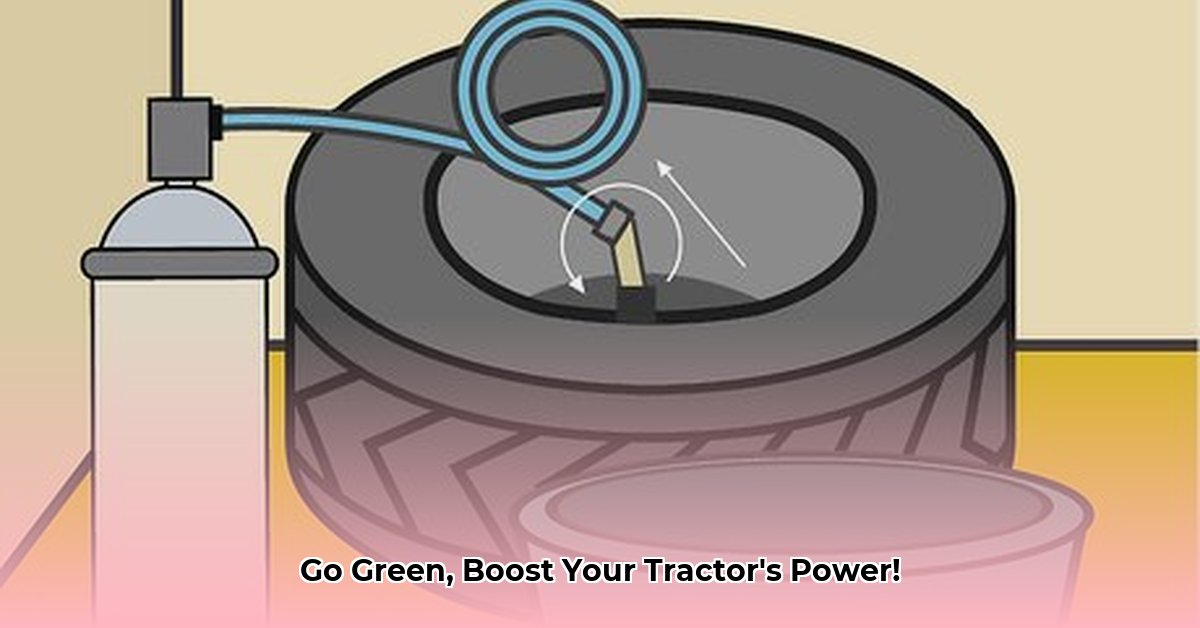
Filling Tractor Tires with Fluid: A Guide to Sustainable Ballast
Choosing the right liquid ballast for your tractor tires significantly impacts operational efficiency and environmental sustainability. This guide compares popular options, helping you select the best fit for your climate, budget, and environmental priorities. We'll explore the advantages and disadvantages of each, providing actionable steps for informed decision-making. For more information on tractor tires, check out this helpful resource: tractor tire guide.
Why Use Liquid Ballast?
Liquid ballast in tractor tires offers several key benefits. Increased tire weight improves traction, enhancing safety and productivity, particularly on slopes and in muddy conditions. This improved grip translates to reduced slippage and faster fieldwork completion. Counterintuitively, heavier tires can also reduce soil compaction, promoting better soil health and crop yields. Choosing the right ballast is key to optimizing these benefits.
Comparative Review of Liquid Ballast Options
Several fluids can serve as ballast, each with unique properties influencing its suitability. Let's compare popular choices:
Water: The Economical Choice
- Pros: Water is inexpensive and readily available, making it a cost-effective solution. It's easy to handle and requires minimal specialized equipment.
- Cons: Water freezes at 32°F (0°C), causing potential tire damage in cold climates. Its relatively low density requires larger volumes to achieve the desired weight. Evaporation and potential contamination are also significant drawbacks.
- Best Use Cases: Water is suitable for warm climates with minimal risk of freezing. Its low cost makes it ideal for applications where cost is a major factor.
Beet Juice: A Biodegradable Alternative
- Pros: Beet juice offers a sustainable and biodegradable alternative to other ballasts. It’s relatively heavy for its volume and generally safer for the environment than some other options.
- Cons: Beet juice is more expensive than water and has a limited lifespan, potentially fermenting or spoiling within the tire. Reliable bulk sourcing may be challenging, depending on your location.
- Best Use Cases: This is an excellent option for environmentally conscious farmers operating in temperate climates, prioritizing sustainability over strict cost minimization.
Antifreeze: Protecting Against Freezing Temperatures
- Pros: Antifreeze solutions offer effective protection against freezing, ensuring tire integrity even in harsh winters. Various formulations accommodate diverse climates.
- Cons: The type of antifreeze significantly influences its environmental impact and safety. Ethylene glycol antifreeze, a common type, is highly toxic and environmentally harmful. Propylene glycol antifreeze is a safer, less toxic, and more environmentally friendly alternative, but it usually commands a higher price. Both can be corrosive over time, depending on tire materials, concentration, and age.
- Best Use Cases: Propylene glycol antifreeze is recommended for cold climates where freezing is a significant concern. The added safety and reduced environmental risk justify the higher cost. Avoid ethylene glycol antifreeze.
Calcium Chloride: Extreme Cold Conditions Only
- Pros: Calcium chloride demonstrates exceptional freeze resistance, remaining liquid in extremely cold temperatures. It offers a relatively high weight density.
- Cons: It's highly corrosive to tires, rims, and associated equipment. Specialized handling and maintenance procedures are necessary to mitigate damage. Improper disposal can also present significant environmental risks.
- Best Use Cases: Calcium chloride is only recommended for regions with exceptionally cold winters and when the potential for corrosion can be managed through proper precautions, equipment, and maintenance practices.
Choosing the Right Ballast: A Step-by-Step Guide
- Assess your climate: Frequent sub-freezing temperatures necessitate antifreeze (propylene glycol) or calcium chloride (with caution).
- Determine Your Budget: Water offers the lowest cost; beet juice and propylene glycol antifreeze are considerably more expensive.
- Prioritize Environmental Responsibility: Beet juice presents the most environmentally friendly choice; water is also relatively harmless when managed appropriately. Avoid ethylene glycol antifreeze.
- Consider Maintenance Requirements: Calcium chloride demands rigorous maintenance due to its corrosive nature.
Table: Liquid Ballast Comparison
| Ballast Type | Freezing Point (°F) (approx.) | Toxicity | Corrosiveness | Cost | Environmental Impact |
|---|---|---|---|---|---|
| Water | 32 | Low | Low | Low | Low (with proper management) |
| Beet Juice | 32 (approx.) | Low | Low | Medium | Low |
| Propylene Glycol Antifreeze | Varies (depending on concentration) | Low | Low | Medium | Medium |
| Ethylene Glycol Antifreeze | Varies (depending on concentration) | High | Low | Medium | High |
| Calcium Chloride | -50 to -60 | Low | High | Low | Medium (due to corrosiveness) |
Safety and Regulatory Compliance
Always follow safety guidelines when handling liquid ballast. Wear appropriate protective gear, particularly when working with potentially toxic substances like antifreeze. Proper disposal methods are crucial; consult local regulations for environmentally sound practices.
Conclusion: Sustainable Practices for Efficient Farming
Selecting the appropriate liquid ballast involves a balanced assessment of cost, climate, environmental impact, and maintenance requirements. This guide provides a framework for making informed decisions, promoting both operational efficiency and responsible environmental stewardship. Remember that ongoing research continues to refine our understanding of sustainable agricultural practices. Staying informed about the latest advancements will help you make the best choices for your farming operation.